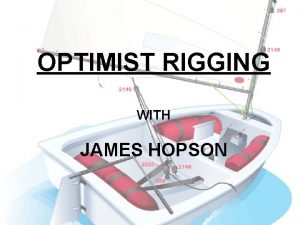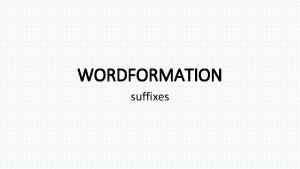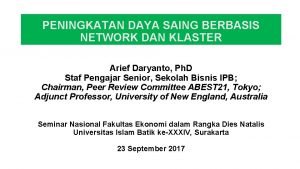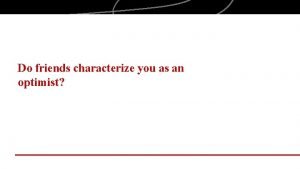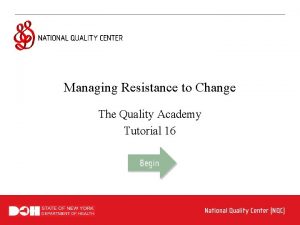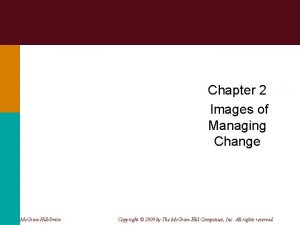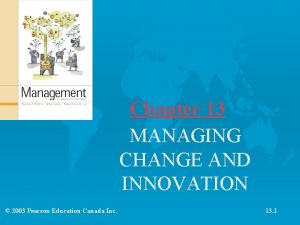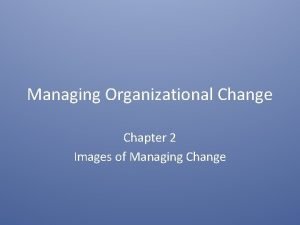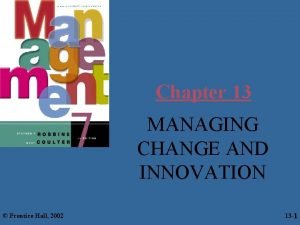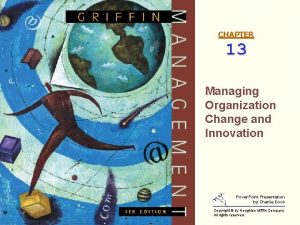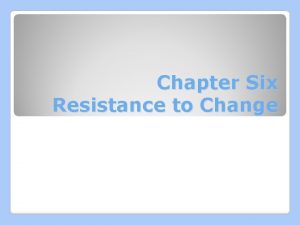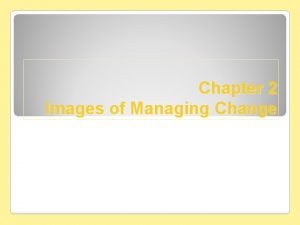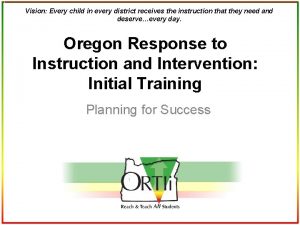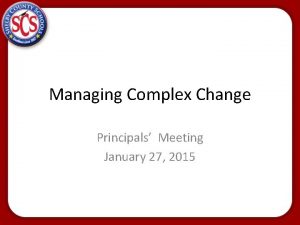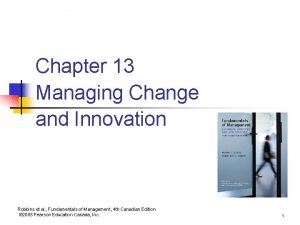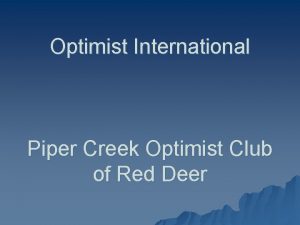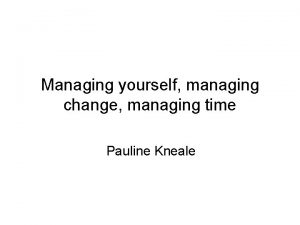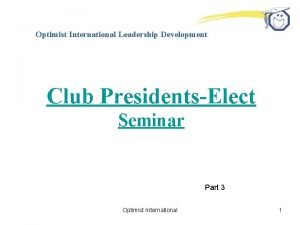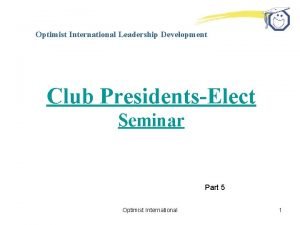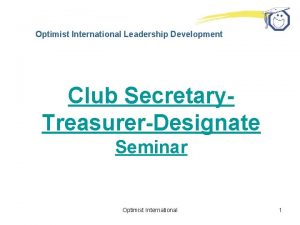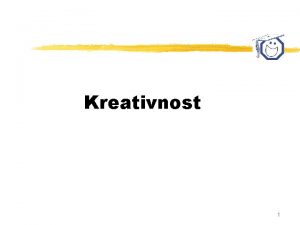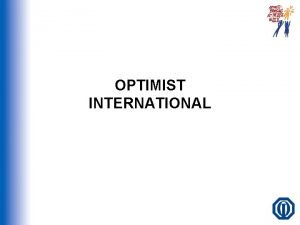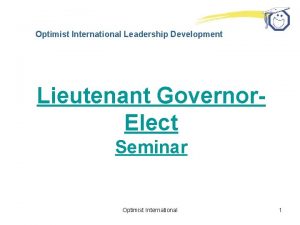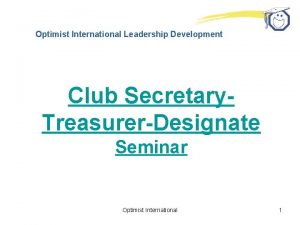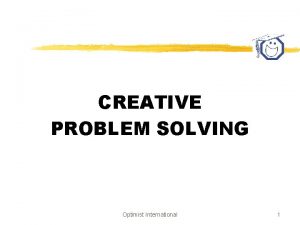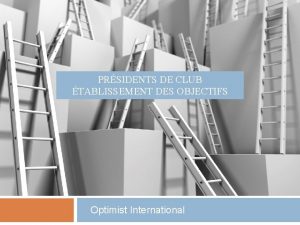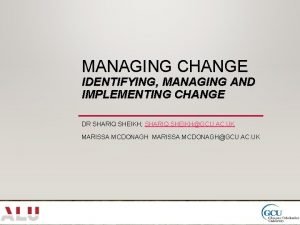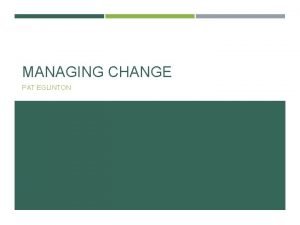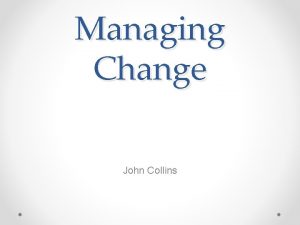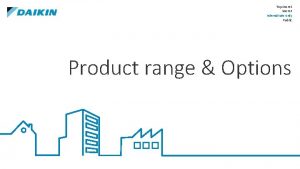MANAGING CHANGE Optimist International 2015 1 The secret




























- Slides: 28

MANAGING CHANGE Optimist International 2015 1

The secret… The Secret of change is to focus all your energy, not on fighting the old, but on building the new. Socrates Optimist International 2015 2

Overview � This module focuses on understanding the change process; recognizing why people resist or embrace change; learning techniques and strategies for breaking through the real-world barriers that get in the way of cooperation and change. Optimist International 2015 3

Objectives 1. 2. 3. 4. 5. Define and understand what is managing change. Understand types of change and recognize conditions facilitating change. Understand why people resist change. The issue of control and the principal factors causing resistance to change. The “X” Chart. Recognize three key factors that must be present for a meaningful change to take place. ØMotivation ØVision ØNext Steps Understand the change process. Ø Unfreeze - Change – Refreeze Optimist International 2015 4

Objectives 6. 7. Understand five most common real-world barriers that get in the way of cooperation and change. Understand five-step strategy for breaking through real-world barriers of change. The strategy of breakthrough negotiations. 8. 9. 10. Identify the “forces for change” and use Force-Field Analysis to help anticipate and remove obstacles to change. § Driving Forces § Resisting Forces Use brainstorming technique in doing a Force-Field Analysis. Understand, plan and manage change. Optimist International 2015 5

Managing Change Outline I. III. IV. V. VIII. IX. X. XI. What Is Managing Change? What Is Change? Why People Resist Change Factors for Meaningful Change The Change Process Reducing Resistance To Change The Breakthrough Strategy Five-Step Strategy for Breakthrough Negotiations Forces for Change Force-Field Analysis Application: Managing Change Optimist International 2015 6

What is Managing Change? A. Someone once said “quote”. Ø “Progress is impossible without change, and those who cannot change their minds cannot change anything. ” - George Bernard Shaw Ø “We cannot become what we want to be by remaining what we are. ” – Max De. Pree Ø “To improve is to change; to be perfect is to change often. ” – Winston Churchill Ø “Anytime there is change, there is opportunity. ” – Jack Welch – CEO, GE. USA Ø “Do not fear going forward slowly; fear only to stand still. ” – Chinese Proverb Ø “Decide today to be a master of change rather than a victim of change. ” – Brian Tracy Ø “Things don’t change. You change your way of looking, that’s all. ” – Author Unknown Ø “Whether you are a success or failure in life has little to do with your circumstances; it has much more to do with your choices!” – Nido Qubein Optimist International 2015 7

What is Managing Change? B. What Is Managing Change? 1. Definition of Managing Change: Understanding how people adjust to change; and knowing how to negotiate the change process successfully. Facilitating acceptance of change. Optimist International 2015 8

What is Managing Change? B. What Is Managing Change? 2. Understanding Change: – Change is all around us. In our personal lives and business there are opportunities every day where disagreements happen. Many times the disagreement occurs because one person wants to change something, move in a different direction, or add or drop an aspect of a business or enterprise. Conflict can arise when one person digs in their heals and resists. Why does this happen? Why is change so hard for us? – Resistance to change is usually neither blind nor irrational. Under normal conditions, people resist changes that negatively affect them and welcome changes that - they believe - positively affect them. That’s rational conduct. Optimist International 2015 9

What is Managing Change? C. Principles for Managing Change 1. Thought processes and _______ dynamics are _______ if change is to be successful. 2. Change only _______ when each person makes a decision to _______ the change. 3. People _______ change when or if it “______” to them. 4. “______” is more important during periods of change and uncertainty than “_______ news. ” Optimist International 2015 10

What is Managing Change? C. Principles for Managing Change 5. Those who demonstrate ______behavior and ______defined values earn ________. 6. A _______ defined vision of the end result enables all the people to define the most ______ path for accomplishing 7. The more _____ people have into defining the changes that will affect their work, the more they will take ________ for the results 8. To change the _______, change the ______. Optimist International 2015 11

II. What is Change A. Definition of Change ØA transition. ØThe process of going from one steady state to another ØChange occurs when the balance of our capabilities against our challenges is disrupted. Optimist International 2015 12

II. What is Change B. Challenge vs Capability ØBALANCED Challenge = Capability ØPOSITIVE Challenge < Capability ØNEGATIVE Challenge > Capability Optimist International 2015 13

II. What is Change C. Types of Change Ø BALANCED Maintain Status Quo Ø POSITIVE New Job, Marriage, Birth of a Child, New Members in Club, New Club Built Ø NEGATIVE Loss of Job, Divorce, Death of Loved One Loss of Club Members, Loss of Club Optimist International 2015 14

III. Why People Resist Change A. Roethlisberger’s X-Chart Change Response Attitudes Personal History Social Situation Optimist International 2015 15

III. Why People Resist Change B. Factors - Resistance to Change Ø Loss of security or status Ø Inconvenience Ø Distrust or uncertainty Ø Cognitive Discord Reduction Optimist International 2015 16

III. Why People Resist Change C. Ø Ø Understanding Control At the heart of understanding how people react to change is the issue of control. People are most comfortable when they can influence what happens to them. People, therefore, feel in control of their lives when their expectations match what they think to be actually occurring. There are two types of control we all seek: Direct – Ability to dictate outcome Indirect – Ability to at least anticipate outcomes Optimist International 2015 17

IV. Factors for Meaningful Change A. Formula for Meaningful Change = Motivation x Vision x Next Steps 1. Motivation Some good reason to give up the status quo 2. Vision A clear and practical vision of the desired future state 3. Next Steps Understanding the next steps required to progress toward the vision Optimist International 2015 18

IV. Factors for Meaningful Change B. Exercise: Square Wheels Ø Ø Reality is that we do not have to constantly invent ideas and frameworks. v. It is less about invention and more about discovery. The framework is that of identifying the ideas that already exist and modeling the behavior of others. v. No sense reinventing the wheel and learning from all the mistakes if we can identify better ways that are proven. Optimist International 2015 19

V. The Change Process Ø Ø Unfreezing – The Present State v. Prepare the individual or group to accept change. Changing - The Transition State v. The specific changes to be introduced must be understood and accepted. Ø Refreezing -The Desired State v. The process by which newly acquired behavior becomes regular behavior Optimist International 2015 20

VI. Reducing Resistance To Change Five Most Commons Real-World Barriers Ø Ø Ø Your Reaction Their Emotion Their Position Their Dissatisfaction Their Power Optimist International 2015 21

VII. The Breakthrough Strategy Five Most Commons Real-World Barriers Ø Ø Ø Your Reaction Their Emotion Their Position Their Dissatisfaction Their Power Optimist International 2015 22

VII. The Breakthrough Strategy Ø The essence of the breakthrough strategy is indirect action. Ø Your single greatest opportunity as a negotiator is to change the game. Ø Breakthrough negotiation is the opposite of imposing your position on the other side. Ø Your job as a break-through negotiator is to clear away the barriers that lie between their NO and the YES of a mutually satisfactory agreement. Optimist International 2015 23

VIII. Five-Step Strategy for Breakthrough Negotiations 1. Stop Your Reaction 2. Overcome Negative Emotions 3. Accept and Re-frame 4. Bridge the Gap 5. Use Power to Educate Optimist International 2015 24

IX. Forces for Change in an individual or organization is influenced by two opposing forces: One that drives for change and one that resists. DRIVING FORCES RESISTING FORCES Driving Forces - initiate change and keep it going. Resisting Forces – act against the driving forces for change EXTERNAL OR INTERNAL Optimist International 2015 25

X. Force-Field Analysis Step 1. Identify and label your present state, and desired outcome in quantifiable terms Step 2. Brainstorm for the driving forces and restraining forces. Step 3. Discuss the items on both sides, and select the forces you can affect or control. Step 4. Design an action plan, which will remove restraining forces and/or strengthen driving forces. Good action plans should contain the following elements: a. The necessary events that must occur. b. A timetable of events. c. Names of people who can contribute. d. Responsibility for implementing the subparts. e. Coordination of the subparts. f. Feedback and evaluation. Optimist International 2015 26

X. Force-Field Analysis UNFREEZE “Present State” Identify driving and resisting forces Driving Forces CHANGE “Transition State” Communicate need for change Resisting Forces REFREEZE “Desired State” Keep communication lines open Get small group of individuals committed to change to help Reinforce the change by communicating positive results of the change Devote extra energy to those who have difficulty accepting the change Celebrate success - thank members for commitment Optimist International 2015 27

XI. Application: Managing Change UNFREEZE CHANGE Identify driving and resisting forces Communicate need for fee increase to membership Driving Forces Resisting Forces Increased expenses Cannot afford it Decreased external funding REFREEZE Keep communication lines open Get small group of individuals committed to increased feed to help Reinforce the change by communicating positive results of the change Devote extra energy to those who have difficulty accepting the fee increase Celebrate success in the club, organization - thank members for commitment Increase not justifiable Dropping membership Optimist International 2015 28
 Optimist international foundation
Optimist international foundation Optimist tuning guide
Optimist tuning guide Athlete suffix
Athlete suffix Piper optimist golf tournament
Piper optimist golf tournament Perahu layar optimist
Perahu layar optimist Balanced optimist
Balanced optimist Gan optimist
Gan optimist Managing complex change
Managing complex change Picture of change management
Picture of change management Organization change and stress management
Organization change and stress management Contemporary issues in managing change
Contemporary issues in managing change Six images of managing change in organisation
Six images of managing change in organisation Contemporary issues in managing change
Contemporary issues in managing change Mengelola perubahan organisasi dan inovasi
Mengelola perubahan organisasi dan inovasi Chapter 13 managing change and innovation
Chapter 13 managing change and innovation Six images of managing change
Six images of managing change Managing change images
Managing change images Managing complex change matrix
Managing complex change matrix Ambrose managing complex change
Ambrose managing complex change The calm waters metaphor
The calm waters metaphor Hình ảnh bộ gõ cơ thể búng tay
Hình ảnh bộ gõ cơ thể búng tay Frameset trong html5
Frameset trong html5 Bổ thể
Bổ thể Tỉ lệ cơ thể trẻ em
Tỉ lệ cơ thể trẻ em Gấu đi như thế nào
Gấu đi như thế nào Thang điểm glasgow
Thang điểm glasgow Hát lên người ơi
Hát lên người ơi Các môn thể thao bắt đầu bằng tiếng nhảy
Các môn thể thao bắt đầu bằng tiếng nhảy Thế nào là hệ số cao nhất
Thế nào là hệ số cao nhất

